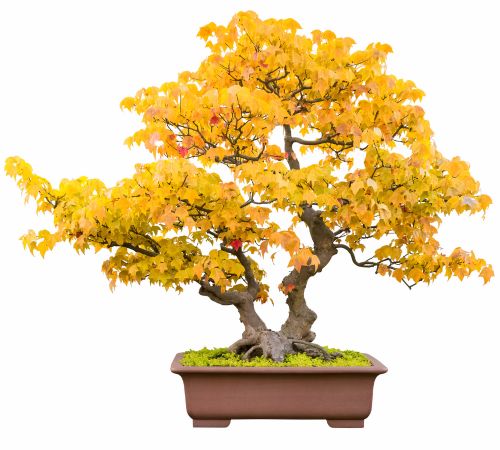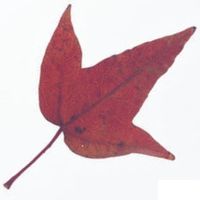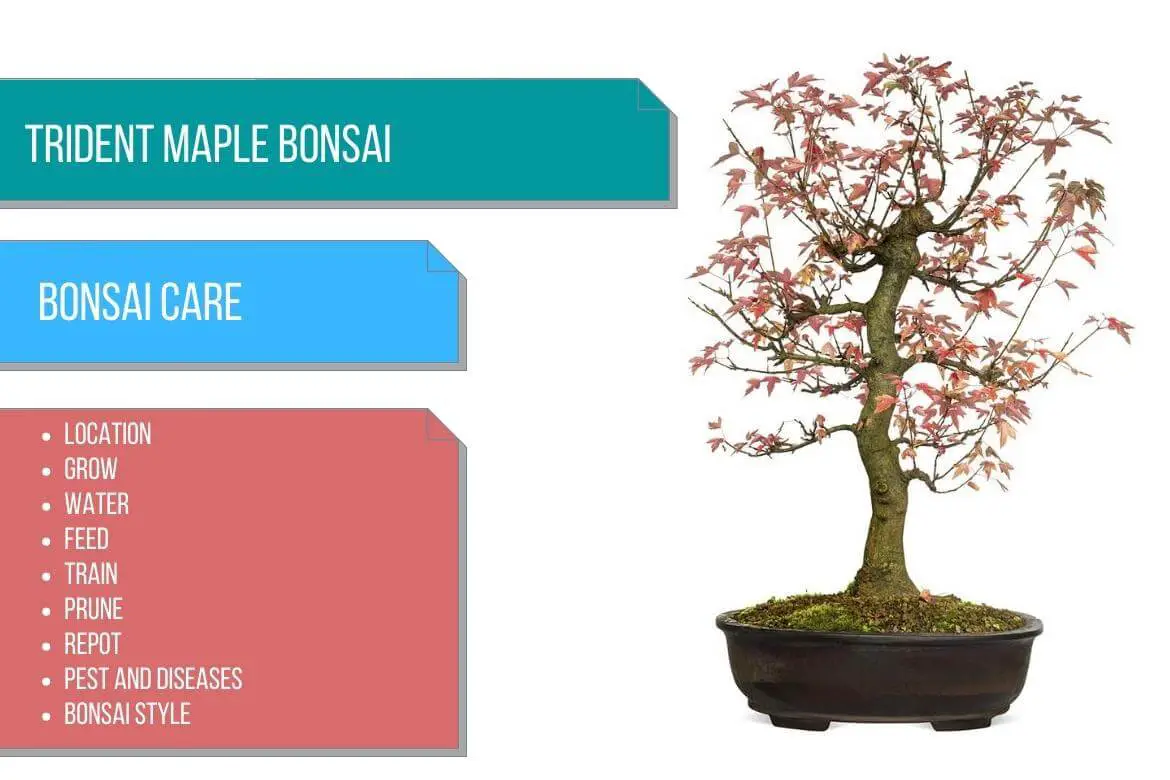
Trident maple
(Acer buergerianum)
Country of Origin : Eastern China & Japan
Bonsai Styles : Root over rock, informal upright, group, twin trunk, slanting
Zone : 5 – 9
Trident maple bonsai are popular bonsai acers, growing rapidly and producing thick trunks quickly.
Root-over-rock style is a popular way to grow the trident maple bonsai trees, making it a favorite among bonsai enthusiasts.
Young trident maple plants are easy to train and can be found in bonsai nurseries in most areas.
Trident maples are primarily imported from Japan and can be divided into three categories:
- Large trunked trees
- Root-over-rock styles
- Young, slender trunked clumps
Trees with large trunks are produced by letting them grow in open ground until they reach a large enough trunk diameter. A final thinning of the trunk to the desired height and removal of all the branches are completed at this stage.
This species is known for its ability to tolerate extreme root pruning, which makes it a perfect bonsai candidate.
The roots of the tree are pruned to a length of few inches. The roots will grow very fast in the bonsai pot.
In autumn, the color of the attractive leaves changes to pink, and in winter, the branch and twig structures give the trees an artistic appearance.

For all other bonsai tree species you can grow, please read : Types of bonsai trees
Best location keep Trident maple Bonsai
A trident maple bonsai tree aka ‘three-lobed maple‘ should always be kept outdoors, except during periods of heavy frost, when it will need to be placed inside a frost-free shed. please read seasonal care for bonsai trees.
Temperatures below 27°F (-3°C) and temperatures above 81°F (27°C) are not considered ideal for Acer buergerianum bonsai. In these situations, move the pot in shade. Also avoid strong direct sunlight exposure as it may damage the leaves. Continue reading do bonsai trees need sunlight for more indoor and outdoor bonsai location ideas.
During their leaf period, they can be displayed indoors for a few days. However, these are predominantly outdoor bonsai trees. Continue reading outdoor bonsai tree care.
Full sun is best for Trident maples bonsai, but the roots should not be allowed to dry out; otherwise, the margins of the leaves will burn.
Providing some afternoon shade is a good idea.
Be sure to protect against strong winds.
Propagation Trident maple
Seeds should be sown in late fall (protected from frost).
Cuttings of softwood (for instance, the width of a pencil, a broom handle, or even the width of a wrist) should be taken in midsummer and hardwood cuttings between late winter and early spring.
Air layering can be done in the spring season.
Watering Trident maple Bonsai
Trident maple bonsai dislike the slightest sign of soil dryness. Throughout the growing season, water daily.
In summer, water the soil each morning and then check again late afternoon, watering if the soil is dry to the touch. Mostly in summers, you may find yourself watering the bonsai twice a day.
In winter, reduce the frequency of watering. Just moisten the soil, and make sure the soil doesn’t get too wet. This will also reduce the risk of frost damage.
Trident maple can tolerate hard tap water. However, it goes without saying that rainwater is the best option whenever possible.
In shallow pots, monitor the moisture in the soil as shallow pots tend to lose moisture at a quicker rate.
Continue reading about how to water a bonsai tree.
Wiring Trident maple Bonsai
Branches should be wired in the fall or spring before new growth or after defoliation.
Be careful with the brittle branches and use aluminum wire for trident maple bonsai training.
Wires should be wrapped in wet cloth and removed as soon as possible to prevent scarring. Remove the wires once they begin to bite into the bark. Do not leave them on for more than six months.
Maple stems are unsightly when they have wire marks on them, so you might want to cover them with raffia.
Avoiding marking can be achieved by shaping with guy wires as well as by pinching and pruning.
Please read our detailed guide on how to wire a bonsai tree. Also, refer to our detailed bonsai tools guide and how to take proper care of your bonsai tools to know about all the tools of bonsai.
Pruning Trident maple Bonsai
When to prune trident maple bonsai?
Pruning trident maple bonsai can be done from late spring to late summer. In mid-summer, pruning branches induces prolific vigorous growth also the cuts will heal quickly. This can be done specially for weak branches to strengthen them. Continue reading How to Prune a Trident Maple Bonsai for a detailed guide.
Dense trees should be defoliated, partially or completely, during the summer. Defoliation will allow light to reach the inner buds. Continue reading how to defoliate trident maple bonsai.
It is possible to cut branches back as far as the trunk. Starting in early spring, pinch out the growing tips of new shoots, continuing through the growing season, to keep the tree in good shape.
Main branches can be trimmed in late winter.
Refer to how to prune a bonsai tree for more info on best practices and tips and tricks.
Pinching Trident maple Bonsai
Once two or four complete leaves have formed on all new shoots, pinch out the tips. This can be done as needed throughout the year.
Repotting Trident maple Bonsai
When to repot trident maple bonsai?
A few times every one to three years, as the buds expand and take on a shiny appearance (before the buds burst open).
Early spring time is a good time to repot.
Apply Akadama or standard soil mix (free draining). For areas with hard water, use some sphagnum moss. OR, you can use 50:50 ratio of akadama and perlite or lava.
In case the trident maple bonsai is not potbound, you can postpone the repotting. Potbound plants have smaller leaves.
Remove circling and damaged roots and prune the roots up to the woody roots. Try and create a strong nebari. These woody roots are needed for stabilizing the plant. Keep as many fibrous roots as possible.
When you repot, don’t remove more than one-third of the roots. It takes the plant quite a while to develop a strong fibrous root ball.
You can read how to repot a bonsai tree to know more about the best guidelines to follow while repotting.
Also, continue reading about how to make bonsai soil at home and how to choose a pot for your bonsai.
Feeding Trident maple Bonsai
Fertilize with a nitrogen rich fertilizer once a month in spring. Reduce the nitrogen content in the feed every month in late summer.
The leaves will be more vibrant in color if you switch to a potassium and phosphate-rich feed in the fall.
OR
During the growing season, feed a balanced general-purpose feed to the plant. Substitute this with a nitrogen-free feed during the fall and summer.
You should not feed your tree during the winter when it is dormant.
A soil acidifier should be applied twice a year in hardwater areas.
Continue reading about bonsai fertilizer and its application.
Diseases and pest of Trident maple Bonsai
Pest-free generally.
Occasionally attacked by aphids. Young shoots are colonized by aphids in spring and their leaves are distorted.
Scale insects and mites can also infest the plant. You can apply a systemic insecticide following the manufacturer’s instructions if you are unable to eliminate these pests by hand.
Dry roots and poor air circulation around foliage can cause powdery mildew.
Why are my trident maple bonsai leaves turning brown?
Some of the common reasons why a trident maple bonsai might end up with brown leaves are:
- Watering: Overwatering or underwatering can both lead to brown leaves. Make sure that you have developed a good watering routine. One quick test you can do is “finger test”. press your finger on the bonsai soil (almost 2 cm deep) and if the soil feels dry, water the bonsai again.
- Lighting: Inadequate or excessive light can cause leaf browning. Trident maples prefer bright, indirect sunlight. If your bonsai is not receiving enough light, consider moving it to a brighter location. On the other hand, if it’s exposed to direct sunlight for extended periods, it may be getting too much light, leading to leaf burn. In such cases, provide shade or filter the sunlight.
- Temperature and Humidity: Extreme temperature fluctuations or low humidity levels can stress the bonsai and cause leaf discoloration. Trident maples thrive in moderate temperatures and appreciate humidity. Avoid exposing your bonsai to cold drafts or hot, dry air from heating or cooling sources.
- Nutrient Deficiency: A lack of essential nutrients can manifest as brown leaves. Make sure you are fertilizing your bonsai regularly with a balanced bonsai fertilizer to provide the necessary nutrients. Follow the instructions on the fertilizer packaging for the correct dosage and frequency.
- Pests and Diseases: Check your bonsai for signs of pests like aphids, spider mites, or fungal diseases. If you spot any infestation or infection, treat it promptly using appropriate pesticides or fungicides specifically formulated for bonsai.
It’s important to note that browning leaves can also be a natural response to seasonal changes or normal aging.
However, if the issue persists or worsens despite your efforts, it may be helpful to consult with a bonsai expert for further guidance specific to your trident maple bonsai.
Refer the in-depth guide for bonsai pest and diseases identification and treatment for more details.
Also, read best practices to keep your bonsai pest free.
Trident maple bonsai care
In winter, a cold wind can kill fine shoots.
Summer winds can scorch leaves, so wind protection is essential in summer.
Trident maple roots are thick and fleshy, and they contain a lot of water. Water-logged roots can crack when the water inside them expands as it freezes when subjected to prolonged freezing.
For trident maple bonsai winter care, make sure the soil – and the roots – remain just moist, and not wet.
To prevent the soil from becoming waterlogged by winter rain, place the trident maple bonsai indoor in a shed or garage.
What to look for when buying Trident maple Bonsai
If you decide to buy root-over-rock or heavy-trunk trident maples, check the trunk for scars or old stumps of old branches. Avoid the tree having either of those defects.
Typically, they are available in large numbers, so it won’t be hard to find one that’s better.
The composition of a group planting (trident maple bonsai forest) should be realistic and add perspective by having trunks of different thicknesses and heights.

